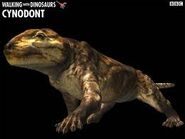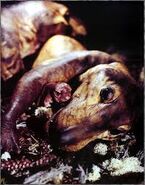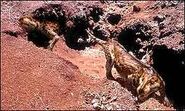| “ | Farther down river is one of the Triassic’s most bizarre animals. The cynodont is a missing link between reptiles and mammals. As he runs, his back-bone moves from side to side like a reptile but he has hair and lives down a burrow like a mammal. | ” |
Thrinaxodon is a genus of cynodont stem-mammal that lived during the early Triassic period (258-225 MYA) in what is now South Africa and Antarctica.
Facts[]
Thrinaxodon was a very close relative to mammals. These animals grew up to half a meter long. Despite being reptile-like, Thrinaxodon was a synapsid and had more mammalian features. Even though these animals were oviparous, females produced milk for their young. Like most small mammals, these animals probably lived in underground burrows. When a male and female Thrinaxodon mated, they would pair for life. While the mother lets her cubs suckle her, the father would carry out house chores like changing the bedding of the burrow.
As some of the Triassic’s most bizarre animals, these small creatures were a missing link between reptiles and mammals. As they ran, their back-bone moved from side to side like reptiles but they had hair and lived down a burrow like a mammal. Females often slept on a bed of lichen. The bond between Thrinaxodons was extraordinarily strong, they paired for life. Like most reptiles, they laid eggs, but after hatching, the young were utterly dependent on their parents and spent their first three months feeding from special milk glands on the mother’s stomach. This form of reproduction had evolved to protect their young from the daylight predators outside their burrows. By day, even the fathers stuck close to the safety of the burrow and carried out domestic chores. The males only hunted at night and possibly their most common prey were baby dinosaurs.
During the night, Thrinaxodon hunted. That was a time when most of the larger predators were asleep. Thrinaxodon hunted small animals, including young dinosaurs. After killing its prey, it would return to its burrow with the food and would feed it to the rest of its family.
Appearances in the programmes[]
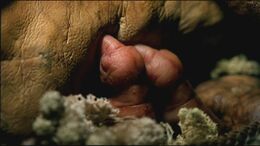
Young Thrinaxodon suckling their mother. (New Blood)
Walking with Dinosaurs[]
New Blood[]
A Thrinaxodon was seen feeding on a shell by the local river before scurrying back to its burrow. It was revealed that it was the father of a family. Whilst the mother slept, her young suckled her for milk and the father carried out domestic chores like replacing the lichen bedding of the burrow.
During the dry season, the Thrinaxodon family was sleeping in their burrow but they were disturbed by an inquisitive pair of Coelophysis. The male ran out the burrow and warded off the pair. Later, the Thrinaxodon couple is seen preparing for a night of hunting. The cubs had become more developed and were allowed to move around the burrow freely. However, one had gone too far and was eaten by a Coelophysis. Its father quickly returned but it was too late.
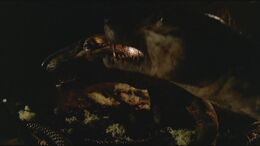
The Thrinaxodon pair attempt to ward off a pair of Coelophysis. (New Blood)
The Coelophysis once again returned to the burrow but were digging it up. The Thrinaxodon pair were becoming desperate but they only had one option. They ate their offspring to give them a better chance of escaping and to deny the Coelophysis their meal. During the night, the pair abandoned the burrow. The Thrinaxodon pair survived their brush with death and one night, and ironically, the male killed a young Coelophysis. It was then revealed that they had laid a fresh clutch of eggs.
Gallery[]
Errors[]
- Thrinaxodon didn't live during the late Triassic period and lived in a different part of Pangaea (Earth's only continent during the Triassic) from animals like Coelophysis and Postosuchus. However, an unnamed species of cynodont is known only from teeth in the Chinle Formation so the reconstruction of this cynodont was therefore based primarily on Thrinaxodon. A replacement would be the recently described Kataigidodon. Even though it was found 21 years after the episode, it lived in the same place and time the episode was set in.
- Although Thrinaxodon lived underground in a burrow in real life, most of its descendants, mammals, live above the ground.
Trivia[]
- Even though it was identified as "Cynodont" in Walking with Dinosaurs, in the books it was identified as Thrinaxodon.

